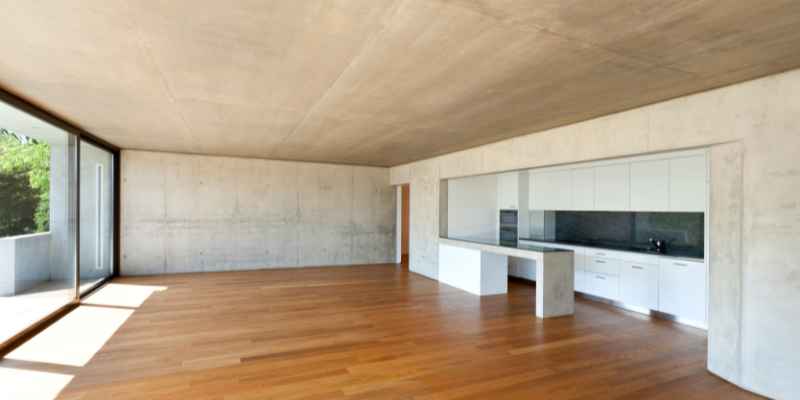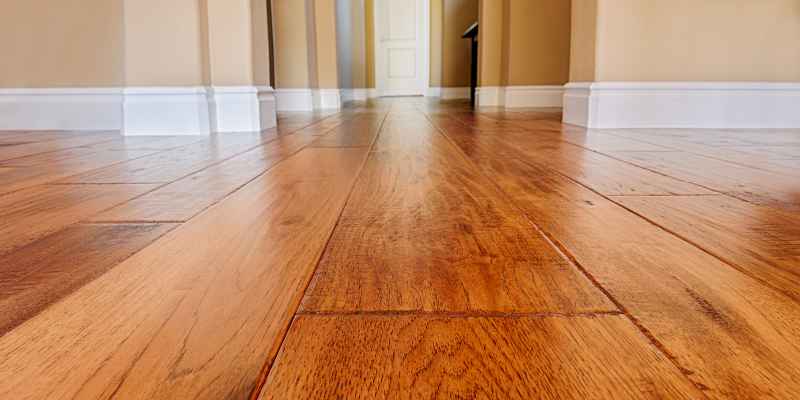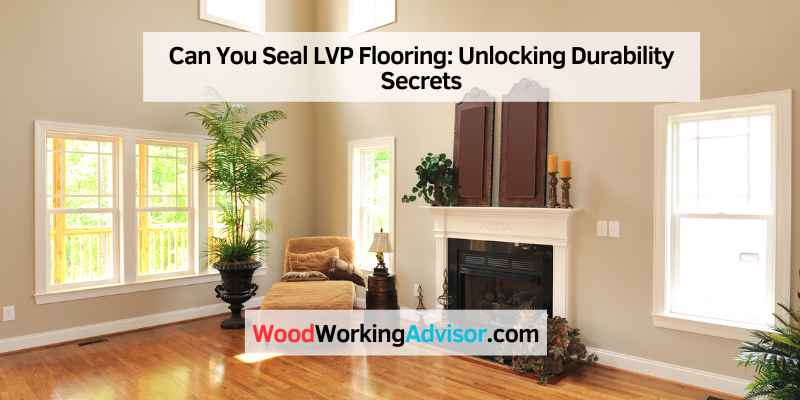Yes, you can seal LVP flooring with vinyl flooring seam sealant available at hardware stores. Applying a vinyl floor sealer is a straightforward process, but it requires time and attention to detail for a successful outcome.
A proper sealing job enhances the durability and longevity of your luxury vinyl plank flooring, protecting it from scratches and wear. In addition to using a sealant, other tips like using furniture pads and area rugs can help safeguard your LVP flooring from potential damage.
By following these steps, you can effectively protect and maintain the appearance of your luxury vinyl plank flooring for years to come.
Introduction To Lvp Flooring
Yes, you can seal LVP flooring to provide extra protection and enhance its durability. Using a vinyl floor sealer, available at hardware stores, can help safeguard your luxury vinyl planks from wear and tear, adding an additional layer of defense against scratches and other damage.
Luxury Vinyl Plank (LVP) flooring is becoming increasingly popular among homeowners. It is a type of flooring that closely resembles real wood or stone, but is much more affordable and easier to maintain. LVP is made of multiple layers, including a durable wear layer that protects against scratches and stains. It is also waterproof, making it perfect for areas prone to spills and moisture, such as bathrooms and kitchens.
Benefits Of Luxury Vinyl Plank
LVP has several benefits that make it a desirable flooring option. Firstly, it is extremely durable and can withstand heavy foot traffic without showing signs of wear and tear. It is also resistant to scratches, stains, and moisture, making it a great option for families with pets and children. LVP is also easy to clean and maintain, requiring only regular sweeping and occasional mopping.
Common Concerns With Lvp
One of the concerns with LVP flooring is that it can be prone to expansion and contraction due to temperature changes. This can lead to gaps between the planks, which can be unsightly and allow moisture to seep in. Another concern is that LVP can be slippery when wet, so it may not be the best option for households with elderly or mobility-impaired individuals.
Can You Seal Lvp Flooring?
If you want to protect your LVP flooring from scratches, stains, and moisture, you may be wondering if you can seal it. The answer is yes, you can seal LVP flooring to provide an extra layer of protection. Vinyl flooring seam sealant can be found online and at most hardware stores. Applying vinyl floor sealer isn’t a complicated process, but it takes time and can be tedious. A poor job or lazy sealer application will result in a subpar sealing job. Another option is to use a flooring finish to protect the top wear layer of the flooring, adding an extra layer of protection against scratches, dents, and nicks.

Is Sealing Lvp Flooring Possible?
Yes, you can seal LVP flooring to provide extra protection and enhance its durability. Applying a vinyl floor sealer is a straightforward process, offering an additional layer of defense against scratches and wear. Proper application is essential for an effective and long-lasting seal.
The Verdict From Manufacturers
When it comes to the question of whether you can seal LVP flooring, the verdict from manufacturers is clear – it is not recommended. Luxury Vinyl Plank (LVP) flooring is designed to be durable and low-maintenance, with a protective wear layer that helps to resist scratches, stains, and moisture. Manufacturers generally advise against sealing LVP flooring because it can interfere with the natural properties and performance of the product.
Sealant Types For Lvp
If you still wish to seal your LVP flooring despite the manufacturer’s recommendations, there are a few types of sealants that you could consider. However, it is important to note that using sealants on LVP flooring may void the warranty and can potentially cause damage.
1. Vinyl Floor Sealer: Vinyl floor sealers are specifically formulated for use on vinyl surfaces. These sealers provide a protective layer that can enhance the shine and durability of the LVP flooring. However, it is crucial to select a sealant that is compatible with your specific type of LVP flooring to avoid any adverse effects.
2. Polyurethane Sealant: Polyurethane sealants are commonly used on various types of flooring, including hardwood and laminate. They provide a strong and durable protective layer that can help to prevent scratches and stains. However, it is essential to choose a water-based polyurethane sealant that is specifically designed for use on vinyl surfaces.
3. Acrylic Sealant: Acrylic sealants are another option for sealing LVP flooring. They can provide a protective layer that enhances the appearance and durability of the flooring. However, like other sealants, it is crucial to ensure that the acrylic sealant is compatible with your specific type of LVP flooring to avoid any potential damage.
It is important to note that before applying any sealant to your LVP flooring, it is recommended to test it in a small, inconspicuous area to ensure compatibility and to assess the desired effect.
In conclusion, while it is technically possible to seal LVP flooring, it is not recommended by manufacturers due to potential damage and warranty issues. If you decide to proceed with sealing, be sure to choose a sealant that is specifically designed for use on vinyl surfaces and test it in a small area first. However, it is generally best to follow the manufacturer’s guidelines and rely on the natural durability and protective properties of LVP flooring.
Sealants And Lvp: A Match?
Wondering if you can seal LVP flooring? Vinyl flooring seam sealant is readily available for purchase. Applying a vinyl floor sealer is a straightforward process, essential for protecting your floors from wear and tear over time.
Compatibility Issues
Sealing LVP flooring can be beneficial, but ensuring compatibility with the type of sealant is crucial.
Pros And Cons Of Sealing
Sealing LVP can provide extra protection against scratches and spills, but improper application may lead to subpar results.
Before sealing your LVP flooring, consider the following:
- Pros of sealing include enhanced durability and protection
- Cons may involve potential damage if not sealed correctly
- Choose a sealant specifically designed for LVP flooring
Always follow manufacturer recommendations for the best results.
Enhancing Lvp Durability
Enhancing the durability of Luxury Vinyl Plank (LVP) flooring is crucial for maintaining its appearance and structural integrity over time. Whether in residential or commercial spaces, LVP can be subject to heavy foot traffic, spills, and general wear and tear. By employing appropriate sealing and alternative durability solutions, you can significantly prolong the lifespan and performance of your LVP flooring.
The Role Of Sealants
Utilizing sealants on LVP flooring can offer an additional layer of protection against scratches, stains, and moisture. Applying a high-quality sealant can help to enhance the durability of the flooring, making it more resilient to daily use and potential damage. Properly sealed LVP flooring is easier to clean and maintain, ensuring its longevity and aesthetic appeal.
Alternative Durability Solutions
Besides sealants, there are other effective strategies to bolster the durability of LVP flooring. Using furniture pads under heavy furniture can prevent scratches and dents. Placing area rugs in high-traffic areas adds an extra layer of protection. Additionally, selecting LVP with a thicker wear layer can enhance its resistance to wear and tear, prolonging its lifespan.
Application Techniques For Sealants
When it comes to maintaining and prolonging the life of your luxury vinyl plank (LVP) flooring, applying a sealant can be a game-changer. Proper application techniques for sealants play a crucial role in ensuring the longevity and durability of your LVP flooring. Here’s a step-by-step guide to help you seal your LVP flooring effectively, along with common mistakes to avoid.
Step-by-step Guide
- Clean the Surface: Thoroughly clean the LVP flooring to remove any dirt, dust, or debris. Use a gentle cleaner and ensure the surface is completely dry before proceeding.
- Choose the Right Sealant: Select a high-quality sealant specifically designed for LVP flooring to ensure compatibility and optimal protection.
- Apply the Sealant: Using a clean microfiber cloth or applicator, apply the sealant evenly across the entire surface of the LVP flooring. Follow the manufacturer’s instructions for the recommended application method.
- Allow for Drying Time: Let the sealant dry completely as per the manufacturer’s guidelines before allowing foot traffic or placing furniture on the treated area.
- Regular Maintenance: Implement a regular maintenance routine to keep the sealed LVP flooring in top condition, including gentle cleaning and avoiding harsh chemicals.
Common Mistakes To Avoid
- Using the Wrong Sealant: Using a sealant that is not specifically formulated for LVP flooring can lead to poor adhesion and unsatisfactory results.
- Insufficient Cleaning: Failing to clean the flooring thoroughly before applying the sealant can result in trapped dirt and imperfections under the sealant layer.
- Uneven Application: Applying the sealant unevenly may lead to an inconsistent finish and inadequate protection in certain areas.
- Rushing the Drying Process: Not allowing sufficient drying time can compromise the effectiveness of the sealant and lead to premature wear and tear.
- Neglecting Regular Maintenance: Overlooking regular maintenance can diminish the longevity and protective properties of the sealant over time.
Maintenance Post-sealing
Sealing LVP flooring is not recommended as it already comes with a protective layer. Applying a sealant can be tedious and may result in a subpar sealing job. Instead, focus on protecting your LVP floor by using furniture pads, area rugs, and furniture glides to prevent scratches and damage.
Cleaning Regimens
After sealing your Luxury Vinyl Plank (LVP) flooring, it’s important to maintain its cleanliness to ensure that the sealant remains effective. The cleaning regimen you choose should be gentle enough to avoid damaging the sealant, yet effective enough to remove dirt and debris. A simple combination of warm water and mild detergent will suffice for most cleaning needs. Avoid using abrasive cleaners or scouring pads, as they can scratch the surface of the LVP and compromise the sealant.
Long-term Care For Sealed Lvp
In addition to regular cleaning, there are several steps you can take to extend the life of your sealed LVP flooring. First, avoid dragging heavy furniture or appliances across the floor, as this can cause scratches and damage the sealant. Instead, use furniture pads or lift heavy items when moving them. Additionally, placing area rugs in high-traffic areas can help protect the LVP from wear and tear. Finally, if you notice any areas where the sealant has worn away or become damaged, it’s important to reseal those sections as soon as possible to prevent further damage.
In conclusion, maintaining your LVP flooring after sealing is a crucial step in ensuring its longevity. By following a gentle cleaning regimen and taking steps to protect the flooring from damage, you can enjoy the benefits of sealed LVP for years to come.
Protecting Lvp Without Sealants
When it comes to protecting your luxury vinyl plank (LVP) flooring, you may wonder if there are alternatives to using sealants. Fortunately, there are several effective methods for safeguarding your LVP without the need for sealants, ensuring its longevity and preserving its aesthetic appeal.
Furniture Pads And Glides
One of the simplest yet most impactful ways to protect your LVP flooring is by using furniture pads and glides. These accessories act as a barrier between the furniture legs and the flooring, preventing scratches, scuffs, and other forms of damage that can occur when furniture is moved or shifted. By equipping your furniture with these protective pads and glides, you can maintain the pristine condition of your LVP flooring for years to come.
Using Area Rugs Effectively
Area rugs serve as an excellent means of safeguarding high-traffic areas on your LVP flooring. Placing area rugs strategically in spaces prone to heavy footfall can help minimize wear and tear, as well as reduce the risk of discoloration or damage from furniture. Additionally, area rugs can add a touch of style and warmth to your living spaces while serving a practical purpose in preserving the integrity of your LVP flooring.
Case Studies And Testimonials
Real-life Sealing Successes
When it comes to sealing LVP flooring, success stories can provide valuable guidance. For instance, homeowners in various regions have shared their positive experiences with effective sealing techniques. These testimonials often highlight the benefits of sealing, such as enhanced durability, resistance to wear and tear, and improved overall aesthetics. By following the right sealing methods, many have been able to prolong the lifespan of their LVP flooring and maintain its pristine appearance for years to come.
When Sealing Goes Wrong
Conversely, it’s crucial to learn from instances where sealing efforts have gone awry. By examining these case studies, one can identify common mistakes and pitfalls to avoid. Whether it’s improper application techniques, the use of unsuitable sealants, or neglecting necessary preparation steps, understanding these failures can help homeowners steer clear of potential sealing mishaps. By heeding the cautionary tales of unsuccessful sealing attempts, individuals can ensure that their own sealing endeavors yield positive and long-lasting results.
Expert Tips For Lvp Owners
Sealing LVP flooring is not necessary as it is already waterproof and durable. However, if you want to add an extra layer of protection, you can use vinyl floor sealer or finish. Make sure to follow the manufacturer’s instructions carefully for a successful sealing job.
Consulting Professionals
When it comes to sealing your luxury vinyl plank (LVP) flooring, it is always recommended to consult with a flooring professional. They can provide you with expert advice on whether or not sealing is necessary for your specific type of LVP flooring. Additionally, they can recommend the best type of sealant to use and guide you through the sealing process.
When To Reseal Your Flooring
It is important to keep in mind that even if your LVP flooring has been sealed, it may need to be resealed periodically. The frequency of resealing will depend on the type of LVP flooring you have, as well as the amount of foot traffic and wear and tear it receives. As a general rule, it is recommended to reseal your LVP flooring every 3-5 years.
If you notice that your LVP flooring is starting to show signs of wear and tear, such as scratches or dullness, it may be time to reseal it. Resealing your flooring can help to protect it from further damage and extend its lifespan.
In conclusion, while it is possible to seal LVP flooring, it is important to consult with a flooring professional and follow their recommendations for sealing and resealing. By doing so, you can ensure that your LVP flooring remains in top condition for years to come.

Frequently Asked Questions
Can You Put A Sealant On Vinyl Plank Flooring?
You can seal vinyl plank flooring using vinyl floor sealant available at hardware stores. Proper application is crucial for effective sealing.
Can You Clear Coat Vinyl Plank Flooring?
Yes, you can clear coat vinyl plank flooring. Applying a clear coat can provide an extra layer of protection and enhance the durability of the flooring. It is important to properly prepare the surface and choose a compatible clear coat specifically designed for vinyl plank flooring.
Can You Put A Protective Coating On Vinyl Flooring?
Yes, you can apply a protective coating on vinyl flooring to enhance durability and resist scratches, dents, and nicks.
How Do I Protect My Lvp Floor?
To protect your LVP floor, use furniture pads, area rugs, and furniture glides to prevent damage. Additionally, consider applying a protective coating or vinyl floor sealer for extra durability and scratch resistance. Regular maintenance and care will ensure longevity and performance of your luxury vinyl flooring.
Conclusion
It is possible to seal LVP flooring to enhance its performance and durability. Vinyl flooring seam sealant can be easily found and applied to the floor. However, it is important to ensure a thorough and careful application to achieve optimal results.
Additionally, using furniture pads, area rugs, and furniture glides can help protect your luxury vinyl flooring from potential damage. Overall, sealing LVP flooring can provide an extra layer of protection and prolong its lifespan.


